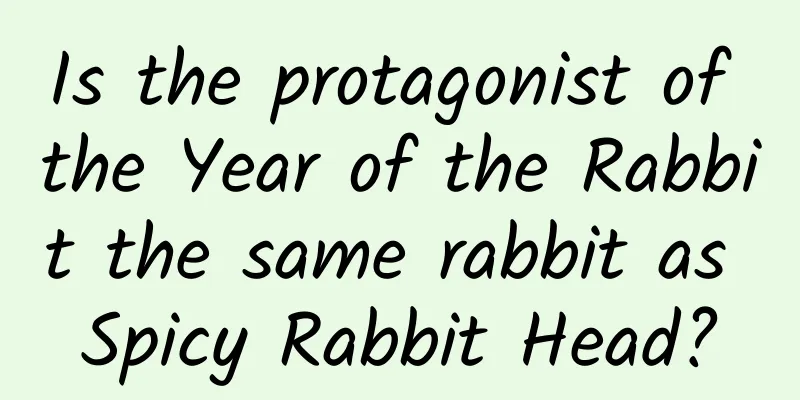Is the protagonist of the Year of the Rabbit the same rabbit as Spicy Rabbit Head?

|
The Year of the Rabbit is approaching, and rabbits are appearing on various advertising posters again, mostly with the image of a little white rabbit - but is the "rabbit" in the Year of the Rabbit really a little white rabbit? The white domestic rabbit is the most common rabbit, but it is actually an imported rabbit that has only been in China for a few hundred years. The real protagonist of the Year of the Rabbit is another rabbit - and it is not the spicy rabbit head you are familiar with. What kind of rabbit does the spicy rabbit head come from? Who is the biggest rabbit eater in China, eating 9 rabbits in 1 second? Can the little white rabbit save my life silently? Please see—— The familiar domestic rabbit is actually a foreign rabbit The domestic rabbit is the rabbit we are most familiar with. There are many varieties. In China, there is a white rabbit variety called "Chinese White Rabbit" (also called "Sichuan White Rabbit"), which is said to be the oldest domestic rabbit domesticated by ancient Chinese. However, all domestic rabbits in the world, including the Chinese white rabbit, regardless of size, length of fur, or drooping ears, are domesticated descendants of the wild European rabbit (Oryctolagus cuniculus). For the sake of convenience, we will call it "rabbit" below. All domestic rabbits in the world are descendants of the burrowing rabbit, which is not white | Alexis LOURS / Pixabay The cuniculus is the only living species of the genus Lepus in the family Leporidae. They like to live in groups in underground burrows that they dig themselves , so they are called cuniculus (the specific epithet cuniculus means "underground tunnel"). Diagram of the underground burrow of a rabbit | Encyclepedia Britannica The native range of the rabbit is very small, limited to the Iberian Peninsula in Europe (Portugal and Spain) and southern France bordering it. Around the Middle Ages, the rabbit began to be domesticated as a house rabbit in southern France. Schematic diagram of the origin of the rabbit | The author made it based on a screenshot of Google Map This domestication process was completed at the latest in the early 16th century, and the brown-gray rabbits were domesticated into white, black, yellow, blue, black and white rabbits. Europeans brought these rabbits to all parts of the world during trade and migration, and gradually more breeds appeared. Medieval illustrations show black-and-white rabbits that do not exist in nature | Tacuinum Sanitatis China is not the origin of the rabbit , and there has never been any rabbit bones in paleontological and archaeological excavation data. Therefore, the earliest white rabbit came to China was in the 16th century, and it is obviously impossible for it to represent the long-standing Year of the Rabbit. What kind of rabbit is native to China? In fact, there are many records about "white rabbits" in ancient Chinese documents. The Bamboo Annals states that in 676 BC, "white rabbits danced in the market in Zhouyang." The Ancient and Modern Notes states that in 6 BC, "a white rabbit with red eyes was found in Shanyang." Where did these white rabbits come from? Now let me introduce the native rabbits in China. In biological classification, they belong to the genus Lepus of the family Lepus. There are 32 species worldwide, 10 of which are distributed in China. They are all wild animals that have never been successfully domesticated and are often called " wild rabbits ", which is hare in English (domestic rabbits and rabbits are rabbits). Hare bones often appear in archaeological excavation data. For example, the rabbit bones unearthed from the Yin Ruins in Anyang are of an undetermined species of the genus Lepus (Lepus sp.), and the rabbit bones contained in the bamboo box in the No. 1 Han Tomb of Mawangdui were identified as the South China rabbit (Lepus sinensis) among wild rabbits. The most common grass rabbit (Lepus tolai) in China | Kudaibergen Amirekul / Wikimedia Commons Both hares and rabbits belong to the family Leporidae and are similar in appearance, but if you compare them carefully, you can see that the hare is larger in size, with noticeably longer ears and hind legs, while the rabbit is more rounded . Comparison of the appearance of rabbits and hares | Oxford learner's dictionaries Regardless of the species, the fur color of hares is yellow-brown . However, "there are occasional white animals in all animals", and albino individuals occasionally appear in a large number of hares. The probability of these albino hares appearing is small, and they were regarded as auspicious by the ancients. They were to be captured and presented to the emperor, and they were also to be recorded - this is the origin of the white rabbits recorded in most ancient documents. Albino European hare (Lepus europaeus) | Walter Randle / Flickr In addition to the albino hares, some white rabbits mentioned in ancient documents are snow hares (Lepus timidus). Snow hares are also a type of hare that live in the coniferous forests of the subarctic circle. In China, they are only distributed in the northeast and northwest regions. In summer, the fur of snow hares is mainly brown, and in winter they will change to white fur, leaving only the tips of their ears black. The "New Book of Tang: Northern Di" says that the Heishui Mohe "are home to many sables and white rabbits", and the "(Qianlong) Qinding Shengjing Tongzhi" says that "white rabbits are like rabbits but larger, with pure white fur, and come from Heilongjiang", which should all refer to winter snow hares. Snow hare (Lepus timidus) molting | Klaus Rudloff / BioLib.cz But you may think of a flaw in this statement - a cunning rabbit has three burrows. The phenomenon of "a cunning rabbit has three burrows" is described in ancient books such as "Strategies of the Warring States", which does not seem to match the wild rabbits that have existed in China since ancient times. Wild rabbits like to move on the ground and are not good at digging holes; while foreign burrowing rabbits love to dig holes and are more likely to have burrows with at least three holes. To be honest, hares are not very good at digging holes. They usually just dig a shallow hole in the grass on the ground and lie down. But they have a skill - when hiding from enemies, they will use the holes that other animals (such as foxes and badgers) have already dug . These holes are 10 to 20 meters long and have about three entrances. In a paper published in the 1990s on the living habits of hares, the author even drew a "Schematic Diagram of the Three Burrows of a Cunning Rabbit". Schematic diagram of the cunning rabbit having three burrows | References [6] How the little white rabbit from outside can take over the show Since the common white rabbits today all have ancestors that came from foreign countries, when and how did they come to China? This story begins with an investment tragedy among the people of Fujian during the Chongzhen period. It is said that in the early years of Chongzhen, domestic white rabbits were brought in from overseas by ship to the ports of Zhangzhou and Quanzhou in Fujian. Because white rabbits were very rare, the people of Fujian would spend all their property to buy them, hoping to get rich by breeding white rabbits , even though they were as expensive as a hundred gold coins. Unfortunately, domestic rabbits reproduced very quickly , and before long, the number of white rabbits increased dramatically, supply exceeded demand, and prices plummeted. As a result, people lost their homes and even hanged themselves. This incident was recorded in Qing Dynasty documents such as "(Kangxi) Ninghua County Chronicles" and "(Guangxu) Zhangzhou Prefecture Chronicles". White rabbit paintings from the Qing Dynasty | Shen Quan The Chongzhen Dynasty in the 17th century was in the so-called Age of Exploration, and global maritime trade was booming. At that time, European countries came to East Asia and Southeast Asia to colonize, plunder and trade. It was at that time that domesticated rabbits were introduced to my country on European ships. In the early Qing Dynasty, rabbits of other colors were also introduced. As the number of domestic rabbits increased, the word "domestic rabbit" began to appear in local chronicles in the middle and late Qing Dynasty. In contrast, native rabbits were called "wild rabbits" and "mountain rabbits". In the late Qing Dynasty, "rabbits" in literature sometimes even referred specifically to domestic rabbits, which shows that domestic rabbits were often raised at that time and were closer to people's daily lives than native wild rabbits, becoming the "rabbit" most familiar to Chinese people. The Sichuan-Chongqing region , a place that cannot be avoided when talking about rabbits, is an important node on the path of the spread of rabbits from coastal areas to the Central Plains. “No rabbit can leave Sichuan alive” | Niu Lian Photography/TuChong Creative Gu Jingxing, a scholar in the late Ming and early Qing dynasties, said in his "Song of White Rabbits": "In the ninth year of Chongzhen, white rabbits were introduced into Dianjiang, and they became abundant and cheap in the Central Plains." "A pair of white rabbits is worth a hundred red rabbits, and they gradually spread to the Central Plains from western Sichuan." In other words, domesticated white rabbits were introduced to Sichuan (including today's Chongqing) during the Chongzhen period, and then from Sichuan to the Central Plains. Sichuan and Chongqing people's love for rabbits began at that time. According to the local chronicles of the Qing Dynasty, it was common for Sichuan people to raise rabbits at that time. In the 1980s and 1990s, Sichuan also saw a larger scale of rabbit breeding. Today, Sichuan is not only famous for its rabbit heads, but is also the largest province in China for raising and eating rabbits. Which rabbit is it in the Year of the Rabbit? If we look at China's long history, it seems that the hare should be chosen as the symbol of the Year of the Rabbit. After all, the "leaping rabbit" in the Book of Songs, the "when the cunning rabbit dies, the running dog is cooked" said by Fan Li in the Records of the Grand Historian, the "lonely white rabbit" in the Ancient Erotic Song, and the "pair of rabbits walking side by side on the ground" in the Ballad of Mulan are all Chinese hares. Three Rabbits | Gong Ji, Qing Dynasty But if we talk about something that is closely related to the lives of Chinese people today, it must be the domestic rabbit . China is the world's largest rabbit-raising country, and the annual export volume of rabbit meat and rabbit hair ranks among the top in the world. The people of Sichuan and Chongqing also cannot do without spicy rabbit heads and cold rabbit. Whether it is a wild rabbit or a domestic rabbit, they are all Chinese rabbits, and they are all good rabbits in the Year of the Rabbit. Whether it's a wild rabbit or a domestic rabbit, they are all good rabbits in the Year of the Rabbit | GypsygGirls / Pixabay References [1] Wang Juan. Research on the Origin of Rabbits in China[J]. Chinese Agricultural History, 2023(01), to be published. [2] Wang Juan. Research on the history of rabbit domestication[J]. Southern Cultural Relics, 2019(04): 174-186. [3] Gu Zilin, Qin Yinghe, Ren Keliang (eds.). Chinese Rabbit Breeding[M]. Beijing: China Agriculture Press, 2013. [4] Smith, J., and Xie Yan, eds. Field Manual of Chinese Mammals[M]. Changsha: Hunan Education Press, 2009. [5] Luo Zexun. Chinese Hare[M]. Beijing: China Forestry Publishing House, 1988. [6] Sun Shaoxiang. Habits, activity patterns and hunting of wild rabbits[J]. Journal of Zoology, 1984(04):26-29. Author: Wang Juan Editor: Mai Mai Cover image source: Pixabay This article comes from the Species Calendar, welcome to forward If you need to reprint, please contact [email protected] |
>>: This is the "New Year's Eve dinner" in the plant world. How many of you know about it?
Recommend
From power outages to world standards, this technology opens up the "high-speed railway" of electricity
From power outages due to poverty to 24-hour brig...
Xiaohongshu Enterprise Account Certification Application Guide
According to the "2020 Xiaohongshu Double El...
20 forms of Internet advertising, 5 billing methods, and 10 ROI evaluation indicators
Internet advertising generally follows the follow...
Tips and precautions for attracting new customers!
Every merchant will conduct some new customer acq...
Plex: 2022 Smart Manufacturing Report
Plex released the "2022 Smart Manufacturing ...
Electric Technology Car News: With its simple exterior and plain interior, is the Venucia M50V going to usurp the dominant position of the Baojun 730?
With the gradual improvement of urban living stan...
Decoding: How does Pinduoduo play with the addiction model?
Pinduoduo has a variety of promotion methods, whi...
Exaggerated! World famous paintings have been hanging upside down for 75 years? What do scientists say about aesthetics?
Recently, the art world has made a ridiculous &qu...
Who is the leader of the aging world? Is there any creature that does not age?
Produced by: Science Popularization China Author:...
APP Operation Tips | App Store "Clear Words" Remediation Guide!
As an APP promotion and operation, keyword covera...
Soft article placement, using 600 yuan to achieve 20,000 yuan of effect
Soft article placement refers to the process of p...
Chinese Valentine's Day copywriting, I finally waited for you!
Please note that the dog-torturing Chinese Valent...
How to design interactive games for e-commerce promotions?
01E -commerce promotion Big promotion stage Big e...
ZIVOO joins hands with Mango to develop dual-software and hardware strategies to expand the large-screen market
In April 2014, Hunan Television announced that it...









